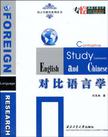对比语言学
1970-1
西北工业大学出版社
刘美岩
192
The book is mainly concerned with the contrastive study between English and Chinese at different linguistic levels,from the lower ones such as phonology, lexicology, syntax to higher ones such as text and stylistics based on modern linguistic and psychological theories. The book starts with a brief introduction to Contrastive Analysis and Error Analysis to facilitate the application of the study results to practical foreign language teaching and research. Then effort is made to find out the similarities and discrepancies between English and Chinese at different levels systematically to shed light on foreign language teaching and translation. One feature of the book lies in its rich examples in illustrating each important point. The bilingual examples can fully demonstrate the con-trasts between the two languages in a clear way. After point-ing out the differences for each point, the author also sug-gests learning difficulties and translation strategies. The book is intended not only for English-major post-graduates, foreign language teachers, and other advanced Chinese learners of English, but also for English learners of Chinese, translators and other language researchers.
The book is mainly concerned with the contrastive study between English and Chinese at different linguistic levels,from the lower ones such as phonology, lexicology, syntax to higher ones such as text and stylistics based on modern linguistic and psychological theories. The book starts with a brief introduction to Contrastive Analysis and Error Analysis to facilitate the application of the study results to practical foreign language teaching and research. Then effort is made to find out the similarities and discrepancies between English and Chinese at different levels systematically to shed light on foreign language teaching and translation. One feature of the book lies in its rich examples in illustrating each important point. The bilingual examples can fully demonstrate the con-trasts between the two languages in a clear way. After point-ing out the differences for each point, the author also sug-gests learning difficulties and translation strategies.
Chapter One Contrastive Analysis1.1 What Is Contrastive Analysis1.2 Background of Contrastive Analysis1.3 Rationale for Contrastive Analysis1.4 Theoretical Assumptions of Contrastive Analysis1.5 Theoretical Basis of Contrastive Linguistics1.5.1 Psychological Basis of Contrastive Analysis1.5.2 Linguistic Basis of Contrastive Analysis1.6 Application of TG Grammar to Contrastive Analysis1.7 Pedagogical Applications of Contrastive Analysis1.8 Criticisms of Contrastive AnalysisChapter Two Error Analysis2.1 What Is Error Analysis2.2 Rationale for Error Analysis2.3 Theoretical Assumptions of Error Analysis2.4 Claims of Error Analysis as a Primary Pedagogical Tool2.5 Describing Errors2.5.1 Error VS. Mistake2.5.2 Levels of Errors2.5.3 Types and Causes of Errors2.6 Techniques for Systematic Error Analysis2.6.1 Introduction2.6.2 Procedures2.7 Computerized Corpora of Errors2.8 Pedagogical Applications of Error Analysis2.9 Modern Contrastive Linguistics and Its SignificanceChapter Three Contrastive Study between Chinese and English in Phonology3.1 What Is Phonology3.2 Phonological Analysis3.3 Two Phonological Models3.3.1 Taxonomic Phonology3.3.2 Generative Phonology3.4 Differences between Chinese and English in Phonology and Difficulties Involved in Learning3.4.1 Differences in Syllable Structure and the General Pattern of Distribution of Consonants and Vowels in the Two Languages3.4.2 Differences between Chinese and English in Consonants and Difficulties Involved3.4.3 Differences between Chinese and English in Vowels and Difficulties Involved3.5 Tones and Intonation3.5.1 Tones in Chinese Language3.5.2 Tones and Intonation in English3.6 Linking in English3.7 Assimilation of Sounds in English3.8 Incomplete Plosives in English3.9 Stress3.10 Difficulties Involved in LearningChapter Four Contrastive Study between Chinese and English in Lexicology4.1 What Is Lexieology4.2 Word Formation of Chinese and English Language4.2.1 Word Formation of Chinese Language4.2.2 Word Formation of English Language4.3 Idioms, Slangs and Colloquial Expressions in Chinese and English4.3.1 Cheng Yu (set phrases) in Chinese4.3.2 Colloquial and Idiomatic Expressions in Chinese4.3.3 Idioms, Colloquialisms and Slangs in English4.4 Sense Relationship in English and Chinese Language4.4.1 Syntagmatic Semantic Relationships4.4.2 Paradigmatic Semantic Relationships4.5 Semantic Field(Semantic Domain/Lexical Field/Word Field)4.5.1 What Is Semantic Field4.5.2 Contrastive Study between English and Chinese in Color System4.6 Coincidence, Parallel and Lexical Gap between English and Chinese4.6.1 Coincidence4.6.2 Parallel4.6.3 Lexical Gap4.7 Difficulties Involved in LearningChapter Five Contrastive Study between Chinese and English in Grammar5.1 What Is Grammar5.2 Morphological Contrastive Study5.2.1 Aspect in English and Chinese5.2.2 Tense in English and Chinese5.2.3 Case in English and Chinese5.2.4 Gender in English and Chinese5.2.5 Mood in English and Chinese5.2.6 Person in English and Chinese5.2.7 Part of Speech in English and Chinese……Chapter Six Contrastive Study between Chinese and English at Text LevelChapter Seven Contrastive Study between English and Chinese in Stylisticce-from some aspectsBibliography
this task is to ask students to describe some sort of real-life situation. The stimulus for such a descriptive task should meet the following four criteria: 1) Represent a realistic communicative task. 2) Provide students with the opportunity to improvise and to use whatever command of the language they may have at their disposal, at their particular level of proficiency. 3) Provide opportunity for generating a variety of errors in sufficient quantity for error analysis. To meet these criteria,the teacher can use a picture story stimulus that portrays people carrying out recognizable activities in familiar places. Picture stories provide several additional advantages apart from their use as elicitation stimuli. First,students seem to enjoy describing picture stories, especially when the stories are imaginative and humorous, and offer challenge to students to use their powers of creativity in a novel way. Second, picture stories provide a specific a mount or substantive information that students are expected to conveyto their listener or reader. Students who have not yet acquired a high level of language proficiency in a foreign language need and welcome the guidance and security that stories provide. Third, the visualin formation of picture serves as a frame of reference when teacher sevaluate the quantity and quality of information in the students communicative task in order to obtain a sample of the students writing proficiency, the teacher gives the students a picture story and asks the mto describe it as fully as possible in the target language. Since the goalis to obtain a sample or the students current mastery of the language,the use of dictionaries or textbooks should not be permitted, nor should students talk to each other while writing picture story composition.

这本书是刘美岩的,其实我想买的是徐余龙的《对比语言学》,因为书名一样,当当网上又没有关于作者的任何信息,所以才会买错。提醒一下大家,别犯跟我一样的错误。
不太满意,语言水平也是一般。